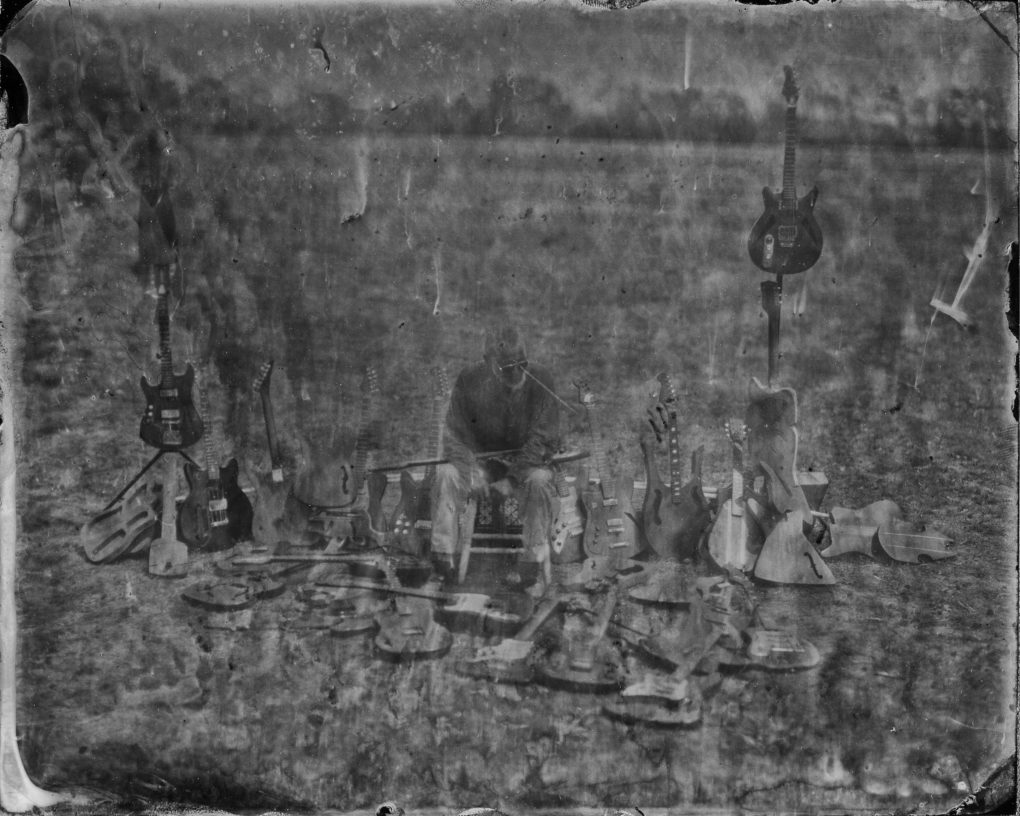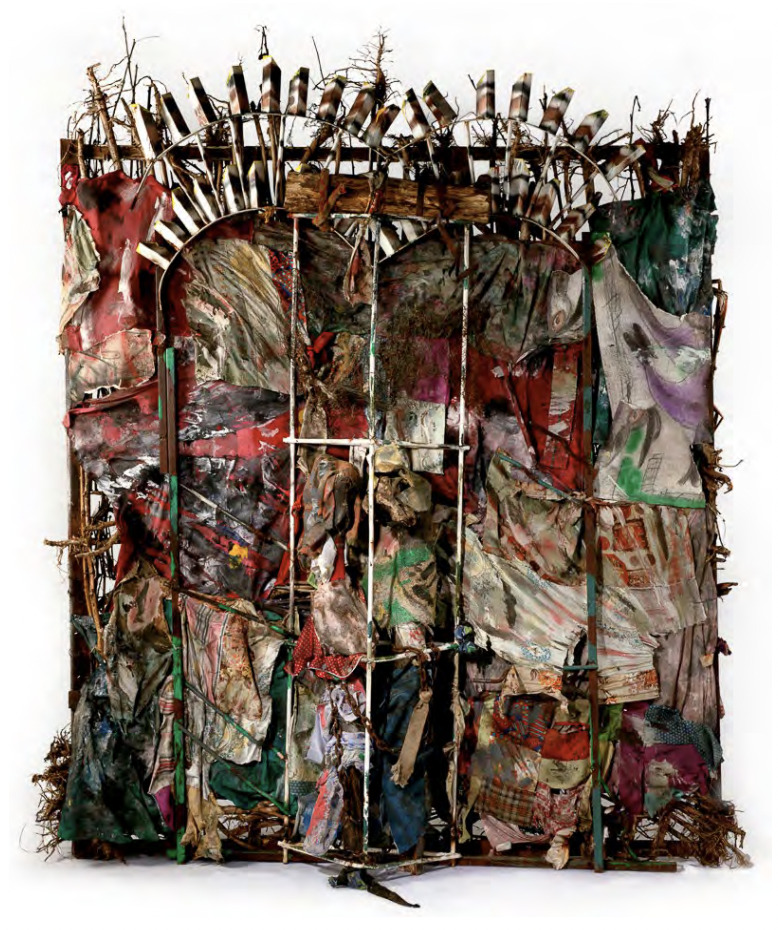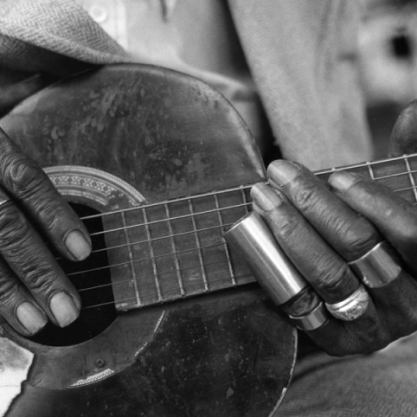Art, Resistance, & CIVIL RIGHTS

By Dr. Will Boone, Lecturer of Music at North Carolina State University.
There is nothing distinctive about a hanging tree. It is just a tree. Yet, some transformation occurs when humans use the tree to lynch another human. The blood of the victim drips on the roots. The material facts of murder become part of the tree’s history.
The lynching can never be undone. For the remainder of the tree’s existence, it will be a hanging tree, an emblem of the hatred and depravity in men’s hearts.
But if humans can transform an ordinary tree into a hanging tree, another kind of transformation is also possible.
Freeman Vines’ work shows us that the story of hatred embedded in a hanging tree can itself be transformed. He took the wood from such a tree and, with the work of his hands, changed it from an instrument of death into an instrument of life.
If his guitars are life-affirming, however, that doesn’t mean they’re easy to look at. The wood of the tree held dark stories. As Vines carved, he revealed images that are terrifying at first sight. But if you sit with the terror and continue to look, you begin to feel the catharsis of the images’ release from the wood. Trapped voices and stories now freed by Vines’ hands. In this catharsis there is a kind of joy. No zipa-dee-doo-dah joy. No escapism. No denial of the brutal facts. But a kind of joy born of the recognition that the brutal facts don’t negate the possibility of transformation.
Vines’ ability to birth such transformational potential from the wood of a hanging tree shows him to be part of a rich tradition of Southern African American artists who collect materials from their surroundings and transform them into artworks that often reveal a deep sense of the interconnectedness of all things, human and non-human.
While the 20th century vernacular musical traditions of southern African Americans— such as blues, gospel, and jazz—became internationally celebrated, the analogous visual art traditions remained comparatively unknown. In recent decades, a few of the artists who worked in these traditions have gained more widespread recognition, but they still remain vastly underrepresented in the art world and in our culture at large.
This lack of representation is unfortunate because these black southern artists present a powerful voice in the ongoing struggles against systematic racism. They articulate densely textured layers of African American heritage, identity, and experience.
Ultimately, they represent one of the richest and most unique artistic legacies in the United States, regardless of the background of the creators or the subject matter of the work.
From rural Emelle, Alabama, Thornton Dial (1928-2016) created art in this tradition throughout his life. Until he met the collector Bill Arnett in the 1980s, however, he had never been to a museum nor seen an art book. He had no concept that other people might see his creations as art. With Arnett as a supporter and promoter, Dial’s works gained renown in the art world. It was not always a smooth ride, but by the time of his death in 2016, Dial’s work had been exhibited in many of the most respected museums in the country, including the Metropolitan Museum of Art in New York.
Like Freeman Vines’ work with the hanging tree, Dial’s art is deeply intertwined with the raw materials he uses to make it.

His piece History Refused to Die is an eight-and-a-half-foot tall assemblage of clothing, collaged drawings, tin, wire, steel, Masonite, steel chain, enamel, and spray paint. This is all densely interwoven with the stalks and roots of okra plants, creating a kind of altar of astonishing color, texture, and complexity. “The plant serves as a metaphor for the shared history—the ‘roots’—of people whose personal genealogies tie back to Africa,” reads the Metropolitan Museum of Art’s description of the work. “Widely associated with Southern cuisine, okra is indigenous to Africa and, like many other foodstuffs, came to the Americas via the international slave trade.” Dial’s work shows the union of African and African American; the layers of culture that black people kept alive despite their oppressor’s attempts to destroy it. Looking at the assemblage from the back, a solitary white dove is perched in the darkly colored okra stalks.
The overall effect is to draw the viewer into a transformational place where opposing forces coexist; a place that is both dark and hopeful, earthly and spiritual, full of gravity and lightness. The transformational potential of Thornton Dial’s artworks began with an encounter between the artist and his raw material.
“I only want materials that have been used by people…that have done people some good,” he once said.
For Dial, there was something inherent in the material itself. By creating art out of these ordinary materials, he was transforming what some folks would consider trash into a sounding board for the past. He was resurrecting, reassembling, remixing, and amplifying stories of the past so that they could live and breathe and speak in the present.
Lonnie Holley is another artist who creates in the tradition shared by Thornton Dial and Freeman Vines. Growing up in the Jim Crow South of the 1950s and 60s, Holley had an unstable and traumatic childhood. He was traded for a bottle of whiskey when he was four. He passed through a succession of caretakers. He was sometimes abandoned and often abused. Holley discovered a calling for art in his late 20s when his sister’s two children died in a house fire. She couldn’t afford tombstones, so he carved them out of sandstone.

Holley has a spiritual kinship with the materials of his art. He collects things—both natural and man-made—that have been discarded, ignored, abandoned, cast off; things that most people consider worthless. Holley, however, attends closely to the inherent beauty of these things and the intricate stories they tell. Working improvisationally, like a jazz musician, he carefully assembles and manipulates his found objects into creations that reveal their immense aesthetic and spiritual value.violence for justice.
There is an inviting warmth to many of Holley’s creations. But viewers drawn in by the calm muted earth tones and surface-level folksiness will also find themselves directly challenged. In Him and Her Hold the Root, for example, a giant gnarled tree root sits atop two ragged rocking chairs, a larger one and a smaller one.
At a glance, the piece suggests a heartwarming “his and hers” story: an old couple rocking on the porch, connected by the strong roots that have anchored them throughout their long life together. But look closer and you see that the root appears to have been violently ripped— perhaps by a lightning strike or a powerful flood—from the tree it once nurtured.
One rocking chair is missing a rocker and only remains upright by leaning on the other. The entire assemblage seems to be under incredible strain. The piece suggests the trauma of uprooted African people, stolen from their home, struggling to hold onto their roots in the land of their kidnappers. But it also shows the beauty of what African Americans have done as they forged on and made a way out of no way.
Lonnie Holley’s art brings us face to face with truths that most of us fail to reckon with. In piece after piece he shows us that there is an inherent worth in material things that we regularly discard and ignore. This shines a light on our rampant wastefulness and our willful blindness to the abundance of grace and beauty that pours out all around us. The transformational potential of Holley’s work comes from the way it confronts us with our own blindness. His art begs us to see the world with new eyes; to pay attention; to recognize the ubiquity of both beauty and suffering. Then, as we see with new eyes, perhaps our actions will follow.
There is a scene in The Man is the Music, a documentary film about Lonnie Holley, where Holley goes to visit his fellow artist, friend, and mentor Joe Minter. Minter’s yard looks like an alternate reality. It is a dense forest of found-object creations, many of them towering into the sky. Hand painted signs are everywhere; some with Bible verses, some with messages of encouragement, some commemorating specific events like natural disasters and episodes of racial injustice. The two men walk together through this labyrinth as Minter rhapsodizes about the ancestors whose spirits enchant, nurture, and protect the grounds. At one point the two men break into a spontaneous duet of “Swing Low, Sweet Chariot.” What comes across is how art is a deeply spiritual pursuit for these creators.
Spirituality is a thread that connects virtually all of the artists working in this southern African American tradition. This spirituality is often informed by Christian stories and symbols but is not restricted to any narrow religious dogma or doctrine. These creators’ work proceeds from a deep sense that all things—human, non-human, living, and non-living—are imbued with spirit. As these artists transform raw materials into art they are engaging in a spiritual encounter; what Freeman Vines calls a “form of meditation.” In this form of meditation, the artist is not the creator, but instead a vessel for a higher creative power.
This is a power that transcends the meager minds of men; a power through which true justice flows. If men can desecrate a tree by making it a hanging tree; this power can consecrate the hanging tree by transforming it into an instrument that turns our hearts toward justice.
Ultimately, southern African American artists like Freeman Vines are guided by spirituality in a way that embodies the New Testament exhortation, “be not conformed to this world: but be ye transformed by the renewing of your mind.” Systems of injustice and inequity continue to operate in our world.
This essay was originally published as part of Freeman Vines’ Hanging Tree Guitars Exhibit in 2020.

Get involved
& give back
The Music Maker Foundation is a 501(c)(3) nonprofit organization that depends on thousands of supporters. Together, we work to meet the day-to-day needs of the artists who create traditional American music, ensure their voices are heard, and give all people access to our nation’s hidden musical treasures. Please contribute or shop our store today.


